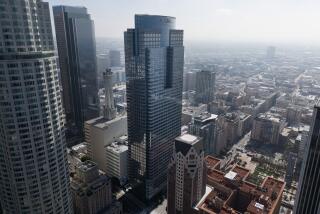System Would Give Buildings Ability to React to Quakes
- Share via
American earthquake scientists are encouraging adoption of a controversial concept first developed in Japan for protecting buildings and bridges against earthquakes.
With an “active control system,” a building is designed to flex -- changing its properties or “resonance” within just seconds -- to cope with incoming earthquake waves.
The system, until now tried mostly in Asia, has met with considerable resistance in the United States.
Sensors at buildings equipped with the system analyze incoming weak P -- or primary -- waves even before strong shaking begins from secondary -- or S -- waves, to determine their frequency, or what is known scientifically as their period.
Once the sensors recognize motion, the structural characteristics of the building are immediately altered by “dampers” that work similarly to an automobile shock absorber, said Hiroo Kanamori, former director of the Caltech Seismology Laboratory.
Kanamori said the system helps avoid what scientists call resonance, a dangerous synchronizing of the movement of the building and the number of earthquake vibrations per second. The system does this by “changing the building characteristics,” he said in an interview with the Caltech Archives.
“The seismometers will sense the ground motion, and they will control all [the] other structures so the other structures don’t shake. It’s kind of a dream, but that’s the active control concept,” he said. “If the ground motion has a period close to the resonance period of the building, the system shifts the period of the building away from it.”
During initial construction, an expensive apparatus must be incorporated into the building to detect the incoming waves and then to change the characteristics of the building.
“Of course, it is expensive,” Kanamori said, “but if the building is destroyed, it’s even more expensive.”
Such systems have been incorporated into about 30 buildings in Japan -- and structures in China, South Korea and Taiwan -- since 1989. None of them, however, has been tested in a major quake, so how the systems will work in reality has not been confirmed.
Kanamori acknowledges that the systems are untested, but he believes that a computerized test could be developed to gauge such a system’s effectiveness without a giant quake actually occurring.
So far, the system has not been tried in any building in the United States.
“The U.S. is lagging behind” Japan, said T.T. Soong, an earthquake engineering professor at the State University of New York in Buffalo.
He blamed a “very conservative” building and engineering community in this country. “Engineers don’t want to pursue this,” Soong said, “in part for liability and insurance reasons.
“Who’s going to insure a building with a new technology?” he asked. “And there are no codes or procedures that allow incorporating this system into new buildings.”
The one time that active control has been employed in the U.S. was when an experiment was done on an Interstate 35 bridge in Oklahoma, an area not known for sizable quakes.
Although the system could be tried in a U.S. building at any time, “it will probably be a few years before it is,” said proponent Shirley Dyke, an associate professor of civil engineering at Washington University in St. Louis. She said the medium- and small-scale computerized tests that have been performed are not as convincing to builders as the actual experience of a major earthquake would be.
“The technology is there right now,” she said. “Some of the systems have been tested, but the most promising systems have not yet been tested in full-scale, large earthquakes.”
One skeptic has been James M. Kelly, a civil and environmental engineering professor at UC Berkeley.
He told a Caltech colloquium on the subject that such a system is “fundamentally flawed” because “the only structures to which it can be applied are large, expensive and not seismically vulnerable.”
“The future direction of structural control research in my view should be toward the improvement of housing, schools and hospitals,” he said. “What is needed is technology and research that provide better building materials ... and better ways of construction within the constraints of local geography, customs and resources.”
In recent years Kanamori -- as well as his Caltech colleague, earthquake engineering professor Tom Heaton, and Bill Spencer, a professor of civil engineering at the University of Illinois -- have emerged as backers of active control, participating in colloquiums on the subject.
They contend that the disciplines of seismology and engineering must be brought closer together before there will be a full trial of the system.
“Usually the seismologist works independently from the engineer,” Spencer said. “Kanamori has been reaching out to the engineering side and making a significant effort to understand the problems from an engineering perspective.”
He believes that active control systems “are more than feasible” and “could effectively control an earthquake.”
And, he says, they could be incorporated for only about 0.5% of a structure’s cost, so that in a $20-million building, the system would add $100,000 to the price tag.
Heaton added: “The idea is a smart brace that can connect and disconnect itself, based on a computer program. The braces have a hydraulic valve that can change the properties of the building like the controlled shock absorbers in a car. The most modern cars have an active suspension system, which reacts to the movements of the wheel.”
Similarly, he said, active control systems measure the accelerations from earthquake waves in the different floors of the building and adjust their suspension systems.
As Spencer put it, “It’s like if you can see a speed bump coming, you can flex your arms and get ready.”
*
Times staff writer Usha Lee McFarling contributed to this report.
More to Read
Sign up for Essential California
The most important California stories and recommendations in your inbox every morning.
You may occasionally receive promotional content from the Los Angeles Times.










